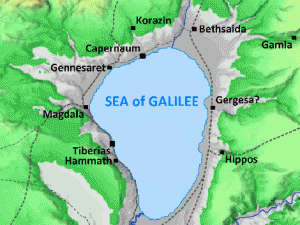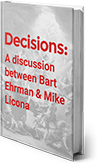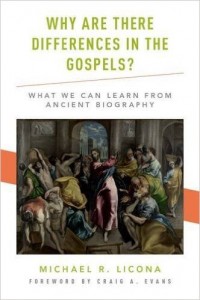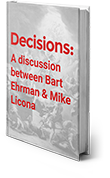Was Mark Confused Pertaining to the Location of the Feeding of the 5,000?
August 22, 2016; Revised August 23, 2016
My next book is scheduled for release this December: Why Are There Differences in the Gospels: What We Can Learn from Ancient Biography (New York: Oxford University Press, 2017—available December 1, 2016). This book is the culmination of seven and a half years of research that sought to gain a fresh understanding pertaining to why the Gospels often differ from one another in their details when reporting the same story. During my research, I read through the Gospels eight times in their original language and compiled a list of the differences I observed. (The differences are more clearly seen in Greek than in English.) The list grew to around 50 pages. I’m now convinced that when one reads the Gospels in view of their biographical nature, more than 90 percent of the differences melt away without having to resort to the sort of hermeneutical gymnastics that are sometimes performed in harmonization efforts.
The Problem
I’m often asked if there are any differences in the Gospels that I don’t think can be resolved by reading them in light of the compositional devices I observe being employed by other ancient historians and biographers. The answer is yes. There are a few. Yet, for most of them, I suspect the author had a good reason for reporting the event as he did; that is, he used a literary device of which I am unaware. I mention these examples in my book. In this article I will touch on the one that I regard as the most difficult to resolve and for which the use of a compositional device is not evident: The location of the feeding of the 5,000.
In order to follow this story, it is helpful to get an idea of the proximity of certain locations mentioned in it. If you imagine the Sea of Galilee, which is actually a large lake, being a clock, Bethsaida is located around 12:30 while Capernaum is around 11:00 and Gennesaret is around 10:00. Luke 9:10 informs us the feeding occurred at or near Bethsaida. The other three Gospels do not tell us where it occurred. However, Matthew and John appear to be in concert with Luke, because they report that Jesus and his disciples crossed the lake immediately after the feeding and landed on the northwest side (Matt. 14:34—Gennesaret; John 6:16-17, 21—Capernaum). John adds that they landed where they had intended. So, according to Luke, Matthew, and John, Jesus fed the crowd at or near Bethsaida (12:30), then the disciples crossed the lake immediately after and landed in the area of Gennesaret/Capernaum (10-11:00).[1]
occurred at or near Bethsaida. The other three Gospels do not tell us where it occurred. However, Matthew and John appear to be in concert with Luke, because they report that Jesus and his disciples crossed the lake immediately after the feeding and landed on the northwest side (Matt. 14:34—Gennesaret; John 6:16-17, 21—Capernaum). John adds that they landed where they had intended. So, according to Luke, Matthew, and John, Jesus fed the crowd at or near Bethsaida (12:30), then the disciples crossed the lake immediately after and landed in the area of Gennesaret/Capernaum (10-11:00).[1]
The difficulty appears after the feeding when in Mark 6:45 we read that Jesus told his disciples to cross over the lake to Bethsaida. This seems difficult to reconcile with Luke’s report that the feeding had occurred at or near Bethsaida. So, what is going on here?
Possible Solutions
Scholars have long wrestled with the tension and have posited a number of solutions with nothing near a consensus emerging.[2] Many conservative commentators posit there were two towns named “Bethsaida.” We know there was a Bethsaida on the northeast side of the lake. So, when John 12:21 speaks of “Bethsaida of Galilee,” these scholars posit that this was a different Bethsaida and that it was located on the northwest side of the lake.[3] While the two-town hypothesis is possible, it is purely speculative and without any solid supporting data.[4]
R. T. France rejects the two-towns hypothesis and instead suggests Luke is mistaken about the location of the feeding being in or near Bethsaida and posits that Jesus instructed his disciples to go to Bethsaida, and that they were blown off course and landed in Gennesaret.[5] But this view does not bode well with John’s report that the disciples landed in Capernaum where they had intended (John 6:17, 21).
James Edwards suggests that the feeding occurred somewhere northwest of the lake and west of Bethsaida. Matthew and John omit the mention of Bethsaida because it would have been a “trivial voyage” from the site of the feeding.[6]
William Lane opts to omit “to the other side” in Mark 6:45, citing a different manuscript tradition.[7] However, this does not solve the tension, since it is the prepositional phrase “to Bethsaida” that introduces it rather than “to the other side.”
Robert Guelich, Paul Achtemeier, and Adella Yarbro Collins suggest that the original tradition had Jesus send his disciples to Bethsaida where he would heal a blind man immediately after the feeding (Mark 8:22-26). However, a pre-Markan redactor broke up the original chronological progression and inserted a number of other stories in the break, including the story of Jesus walking on water. This created a Markan sandwich.[8] However, this would be an exceedingly awkward move on Mark’s part, given all that transpires in 7:1-8:21. Moreover, it requires that John was following Mark as a source, a position that is rejected by the majority of scholars.
R. C. H. Lenski and James White suggest that the Greek pros Bethsaidan in Mark 6:45 should be translated “toward Bethsaida” instead of “to Bethsaida.” Lenski says this would fit well, since the town was a suburb of Capernaum.[9] However, Mark goes on to say that they landed in the region of Gennesaret. And while Gennesaret and Capernaum could be said to belong to the same region, including Bethsaida would be a stretch. Moreover, there are reasons that suggest “toward Bethsaida” is not the best translation for pros Bethsaidan in this context. Let’s consider a few.
White contends that the feeding occurred on the plains of Bethsaida (1:00-2:00), that Jesus instructed his disciples to cross the lake, and that they would pass “by” or go “toward” Bethsaida in the process. This would fit with Mark 6:53 which says they crossed over and came to Gennesaret. While pros can mean “by” or “toward,” if that were the meaning here, including the phrase would be unnecessary. Imagine being one of Jesus’ disciples when he instructs you to get in a boat and cross the lake toward Bethsaida. Wouldn’t some of you have wanted to say, “Okay, Lord. And then what? It’s a big lake. Where do you want for us to go?” I live in the Atlanta area. So, it would be similar to me saying to my wife Debbie, “Please get in the car and drive toward/by Buckhead.” She would say, “Okay. You’ve given me a direction in which to proceed. But where do you want me to go?” Now one might reply, “Jesus may have told them to go toward/by Bethsaida on their way to Gennesaret” (literally “Cross over to the other side by/toward/passing Bethsaida and arrive in Gennesaret”) and Mark omitted the portion about Gennesaret. However, in this case the phrase “toward/by Bethsaida” would be utterly unnecessary to add if you’re going from 1:00-2:00 to 10:00-11:00, because it’s directly across the lake. Surely some of the disciples would have thought to themselves, “Does he think we’re stupid? We’re fishermen who make our living on this lake. Of course, we’ll be passing by Bethsaida! Does he think we were going to go all the way down to 6:00 then up to 10:00?”
Indeed, there is an even stronger reason for preferring “to” over “toward” or “by.” There are 65 occurrences of pros in Mark, 42 in Matthew, 166 in Luke, and 102 in John. It almost always appears in the accusative case in the Gospels, exceptions being where it appears as an infinitive (Mark 13:22 Luke 18:1; Matt. 5:28; 6:1; 13:30; 23:5; 26:12) and in the dative case (Luke 19:37; John 20:11, 12 [2x]).[10] Pros can have nuanced meanings when it is connected to nouns appearing in different cases (e.g., pros + genitive; pros + dative; pros + accusative).[11] When accompanied with the accusative that refers to a place as we observe in Mark 6:45, it usually signifies going to that place. Exceptions can be cited. But that is the most common meaning by far.[12] And we can focus even further for a more precise meaning when we consider the specific grammatical construction in Mark 6:45:
And immediately, he compelled his disciples to get in the boat and go ahead to the other side (eis + accusative) to Bethsaida (pros + accusative). –Mark 6:45
Here we observe a verb of going, “to go ahead” (proagein), combined with a location described by two prepositions followed by accusatives: to the other side (eis + accusative), to Bethsaida (pros + accusative). [Verb of going + location described by eis + accusative and pros + accusative.] This grammatical construction appears 10 times in the New Testament, seven of which are in the Gospels, one in Acts, and two in Paul’s letters. Lets look at a few:
And when they drew near to Jerusalem (eis + accusative), to Bethphage and Bethany (eis + accusative), to the Mount of Olives (pros + accusative), he sent two of his disciples. –Mark 11:1
This same construction appears in the parallel text in Luke:
And having said these things, he continued ahead going up to Jerusalem (eis + accusative). And it came about as he drew near to Bethphage and Bethany (eis + accusative), to the mount called ‘Olives’ (pros + accusative), he sent two of his disciples. –Luke 19:28-29[13]
Bethphage and Bethany are located on the eastern slope of the Mount of Olives.[14] Thus, pros + accusative is here used to provide an additional description of the location mentioned in relation to eis + accusative.
Lets look at another example. After Jesus healed a demoniac, he said to the man,
Go to your home (eis + accusative), to your people (pros + accusative) and announce to them the great things the Lord has done for you and had mercy on you. –Mark 5:19
The pros + accusative further describes the man’s home (eis + accusative).
Here’s another example:
And Jesus went up to them (pros + accusative) into the boat (eis + accusative). –Mark 6:51
As with the previous examples, the pros + accusative and eis + accusative are descriptions of the same location. Remaining examples in the New Testament include Matt. 26:18, Luke 4:26, Acts 20:6, Gal. 1:17; Titus 3:12.
In every instance, when a verb of going is followed by two accusatives of location (eis + accusative and pros + accusative), the two prepositional phrases are providing descriptions of the same location. These texts weigh heavily in favor of understanding Mark 6:45 to be reporting that Jesus instructed his disciples to go “to Bethsaida” and is another reason why that rendering is to be preferred over “toward Bethsaida.” Most translators agree. Of 28 English translations, only three render pros Bethsaidan as “near Bethsaida” or “toward Bethsaida” (New Jerusalem Bible, New American Bible, Common English Bible).[15]
One might posit that the prepositional phrase “to Bethsaida” in Mark 6:45 was a scribal error later added but was not in the “original” Mark. But that would be entirely ad hoc, since there are no manuscripts that omit the phrase.
Finally, we may posit that Mark was confused. This is first suggested by the fact that Luke locates the feeding in Bethsaida, the northeast side of the lake, and Matthew and John then inform us the disciples crossed over to the northwest side of the lake and landed, with John adding they landed in Capernaum where they had intended. But Mark has them instead intending to cross over to Bethsaida but landing on the northwest side. Second, the tension would not exist if Mark had said, “And immediately, he urged his disciples to get into the boat and go ahead of him to the other side” and had not added “to Bethsaida” (6:45). Matthew may have known this and omitted “to Bethsaida” (see Matt. 14:22) in order to avoid the tension it created.
However, it’s also possible that some simplification may be occurring with Matthew and John. Although Luke 9:10 says Jesus and his disciples went to Bethsaida, 9:11-12 appear to suggest that they had gone outside the village when Jesus fed the five thousand, since the disciples asked Jesus to send the people away to the surrounding villages and countryside for lodging and food, because they were in a desolate place. Since Bethsaida is on the east banks of the Jordan River, it is possible that Jesus and his disciples had retreated to the western banks of the river and that is where the feeding had occurred. Jesus then instructed his disciples to return to Bethsaida for supplies or for some other reason before proceeding to the northwest side of the lake. In that case, Matthew and John simplified the story by omitting the brief stop in Bethsaida. Matthew, in fact, often simplifies by omitting these sort of details and John simplifies elsewhere, too.[16]
Conclusion
We have looked at a number of solutions to the tension created by the prepositional phrase “to Bethsaida” in Mark 6:45. While some are less ad hoc and more plausible than others, none of them enjoys anything close to a scholarly consensus on what is going pertaining to that resulted in the difference. In my study of how Plutarch tells the same stories differently, there are a few instances for which I remain puzzled and do not know what Plutarch had in mind that led to the differences.[17] I find myself in a similar situation with the location of the feeding of the five thousand. In fact, the puzzle is more complicated than I had thought. My study of differences in Plutarch and the Gospels informs me that there is often more going on in history than is visible on the surface when being described by historians. Ancient authors were unaware that modern readers would be assessing their writings under a microscope as we are doing. So, unless and until more data surfaces that allows us to decide the matter with greater certainty, we cannot know what actually led to the difference in the reports we have examined here. Therefore, I remain content to live with an unanswered question.
Notes:
[1] Luke does not mention the crossing but transitions to a different event and time.
[2] Not addressing the tension is AYBC, Mark (Joel Marcus), Black’s NTC, Mark (Morna D. Hooker), Mark: A Socio-Rhetorical Commentary (Ben Witherington, III).
[3] See UBS, A Translator’s Handbook: Mark (Robert G. Bratcher & Eugene A. Nida); NAC, Mark (James A. Brooks); ICC, Mark (Ezra P. Gould); Baker NTC, Mark, Baker NTC, John (William Hendriksen); Mark (H. A. W. Meyer); Expositor’s Greek NT, Mark (W. Robertson Nicoll); The Gospel According to Peter: Mark and I & II Peter (Bob Utley).
[4] See Mark (John Peter Lang): the two Bethsaidas hypothesis “appears entirely groundless”; Mark (Henry Barclay Swete): “there is no direct evidence for the existence of two Bethsaidas on the Lake.” Neither Lang nor Swete offer a solution to the tension. NAC, Mark (James A. Brooks) posits the two-town hypothesis but admits, “No solution is possible on the basis of present knowledge.”
[5] NIGTC, Mark (R. T. France). See also IVP NTC Mark (Ronald J. Kernaghan); Mark (Robert H. Gundry) who posit that the disciples started out for Bethsaida, were blown off course and landed in Gennesaret.
[6] Pillar, Mark (James R. Edwards).
[7] NICNT, Mark (William Lane).
[8] WBC, Mark (Robert Guelich); Paul J. Achtemeier, “Toward the Isolation of Pre-Markan Miracle Catenae” in JBL 8.9, no. 3; Hermeneia, Mark (Adela Yarbro Collins).
[9] Mark (R. C. H. Lenski). For White, see https://youtu.be/Pgk0don6HEE?t=45m beginning at 48:00.
[10] Of 375 occurrences of pros in the Gospels, only 11 (or 3%) are not connected with an accusative.
[11] For those who do not read Greek, the dative case is often equivalent to the English indirect object, while the accusative case is often equivalent to the English direct object.
[12] See the two most authoritative Greek lexicons consulted by today’s scholars: BDAG and Liddell-Scott.
[13] Matt. 21:1 is a parallel text to Luke 19:28-29. Matthew substitutes eis for pros, showing the terms can be used interchangeably.
[14] Accordingly, the NASB is mistaken in its rendering of Mark 11:1, “As they approached Jerusalem, at Bethphage and Bethany, near the Mount of Olives, He sent two of His disciples.”
[15] Other English translations render as “to Bethsaida” (ASV, BBE, HCSB, Darby, Douay-Rheims, ERV, ESV, GWN, Magiera NT Peshitta Translation, McDonald Idiomatic Translation, NASB, NET, NIV, NKJV, NLT, NRSV, Revised Patriarchal Greek Orthodox NT, RSV, Revised Webster, Webster) and “unto Bethsaida” (Geneva Bible, KJV, Bishops NT, Tyndale’s NT, Young’s Literal Translation).
[16] See chapter four in my book Why Are There Differences in the Gospels?
[17] See chapter three in Why Are There Differences in the Gospels?







